Peptide-based Infection Therapeutics Market
Peptide-based Infection Therapeutics Market Size and Share Forecast Outlook 2025 to 2035
The peptide-based infection therapeutics market is projected to grow from USD 1.4 billion in 2025 to USD 3.0 billion by 2035, at a CAGR of 7.9%. Bacterial will dominate with a 54.0% market share, while direct antimicrobials will lead the modality segment with a 49.0% share.
Peptide-based Infection Therapeutics Market Forecast and Outlook 2025 to 2035
The peptide-based infection therapeutics market stands at the threshold of a decade-long expansion trajectory that promises to reshape antimicrobial treatment and infection management solutions. The market's journey from USD 1.4 billion in 2025 to USD 3.0 billion by 2035 represents substantial growth, the market will rise at a CAGR of 7.9% which demonstrating the accelerating adoption of advanced peptide antimicrobial technology and infection control optimization across healthcare facilities, pharmaceutical companies, and global therapeutic markets.
The first half of the decade (2025-2030) will witness the market climbing from USD 1.4 billion to approximately USD 2.0 billion, adding USD 0.6 billion in value, which constitutes 38% of the total forecast growth period. This phase will be characterized by the rapid adoption of direct antimicrobial peptides, driven by increasing antibiotic resistance challenges and the growing need for novel infection treatment solutions worldwide. Enhanced peptide formulations and targeted pathogen mechanisms will become standard expectations rather than experimental options.
The latter half (2030-2035) will witness continued growth from USD 2.0 billion to USD 3.0 billion, representing an addition of USD 1.0 billion or 62% of the decade's expansion. This period will be defined by mass market penetration of host-defense peptide therapies, integration with comprehensive infection management platforms, and seamless compatibility with existing antimicrobial treatment infrastructure. The market trajectory signals fundamental shifts in how healthcare facilities approach infection treatment optimization and antimicrobial resistance management, with participants positioned to benefit from growing demand across multiple pathogen types and therapeutic modalities.
Quick Stats for Peptide-based Infection Therapeutics Market
- Peptide-based Infection Therapeutics Market Value (2025): USD 1.4 billion
- Peptide-based Infection Therapeutics Market Forecast Value (2035): USD 3.0 billion
- Peptide-based Infection Therapeutics Market Forecast CAGR: 7.9%
- Leading Pathogen Target in Peptide-based Infection Therapeutics Market: Bacterial
- Key Growth Regions in Peptide-based Infection Therapeutics Market: North America, Western Europe, and East Asia
- Top Key Players in Peptide-based Infection Therapeutics Market: Melinta/IQVIA, Pfizer, Merck, Roche, Polyphor
- Where revenue comes from - Now Vs Next (Industry-level view)
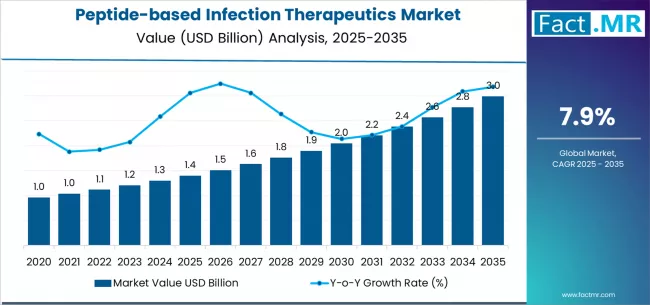
| Period | Primary Revenue Buckets | Share | Notes |
|---|---|---|---|
| Today | Bacterial infection treatments | 54% | Antibiotic-resistant pathogen focus |
| Viral infection therapeutics | 28% | Emerging viral treatment applications | |
| Fungal/other pathogen treatments | 18% | Specialized antimycotic applications | |
| Direct antimicrobial peptides | 49% | Traditional bactericidal mechanisms | |
| Future (3-5 yrs) | Multi-drug resistant bacterial treatments | 60-65% | Advanced resistance circumvention |
| Host-defense peptide expansion | 35-40% | Immune system enhancement approaches | |
| Combination antimicrobial therapies | 20-25% | Synergistic treatment protocols | |
| Hospital IV administration | 55-60% | Critical care and severe infection focus | |
| Topical application expansion | 15-20% | Skin and wound infection treatments |
Peptide-based Infection Therapeutics Market Key Takeaways
At-a-Glance Metrics
| Metric | Value |
|---|---|
| Market Value (2025) → | USD 1.4 billion |
| Market Forecast (2035) ↑ | USD 3.0 billion |
| Growth Rate ★ | 7.9% CAGR |
| Leading Pathogen Target → | Bacterial |
| Primary Treatment Modality → | Direct Antimicrobials |
The market demonstrates strong fundamentals with bacterial infection treatments capturing a dominant 54% share through advanced antimicrobial capabilities and resistance circumvention optimization. Direct antimicrobial peptides drive primary therapeutic approach at 49%, supported by proven bactericidal efficacy and clinical validation preferences for targeted pathogen elimination.
Geographic expansion remains concentrated in developed markets with established healthcare infrastructure, while emerging economies show accelerating adoption rates driven by infection burden and antimicrobial resistance challenges.
Imperatives for Stakeholders in Peptide-based Infection Therapeutics Market
Design for resistance challenges, not just infection control
- Offer comprehensive treatment packages: peptide therapeutics + resistance monitoring + combination protocols + clinical support + antimicrobial stewardship integration.
- Preconfigured treatment protocols: dosing optimization, resistance prevention, clinical monitoring, and antimicrobial management systems.
Multi-modal approach readiness
- Combination therapy platforms, synergistic treatment protocols, and integrated antimicrobial systems with resistance prevention capabilities.
Clinical validation-by-default
- Comprehensive efficacy testing, resistance profiling, safety validation, and regulatory compliance documentation support.
Hospital-focused delivery without complexity
- Clear clinical protocols + transparent efficacy data; specialty care integration and critical care compatibility systems.
Segmental Analysis
Primary Classification: The market segments by pathogen target into bacterial, viral, and fungal/others categories, representing the evolution from broad-spectrum antimicrobials to specialized infection treatment systems for diverse pathogen management optimization.
Secondary Classification: Modality segmentation divides the market into direct antimicrobials, host-defense peptides, and conjugates/others sectors, reflecting distinct requirements for pathogen elimination, immune enhancement, and targeted delivery standards.
Tertiary Classification: Setting segmentation covers hospital/IV, outpatient/oral, and topical applications, while therapeutic areas span critical care, infectious diseases, dermatology, and wound care management.
Regional Classification: Geographic distribution covers North America, Western Europe, East Asia, and emerging markets, with developed regions leading adoption while developing economies show accelerating growth patterns driven by infection burden programs and healthcare infrastructure expansion.
The segmentation structure reveals therapeutic evolution from traditional antibiotics toward specialized peptide-based systems with enhanced resistance circumvention and targeted pathogen elimination capabilities, while application diversity spans from critical care to specialized infection management requiring precise antimicrobial intervention solutions.
By Pathogen Target, the Bacterial Segment Accounts for Dominant Market Share
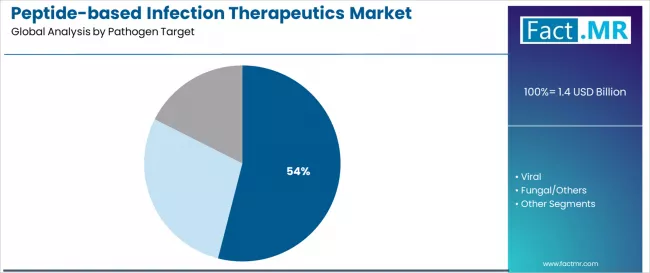
Bacterial infection treatments command the leading position in the peptide-based infection therapeutics market with 54% market share through advanced antimicrobial features, including multi-drug resistance circumvention, targeted bacterial elimination, and infection control optimization that enable healthcare providers to achieve optimal patient outcomes across diverse hospital and clinical treatment environments.
The segment benefits from healthcare provider preference for reliable antimicrobial systems that provide consistent bacterial elimination, reduced resistance development, and infection management optimization without requiring complex treatment modifications. Advanced mechanism features enable rapid bactericidal activity, resistance prevention, and integration with existing antimicrobial protocols, where efficacy performance and safety reliability represent critical patient care requirements.
Bacterial infection treatments differentiate through proven antimicrobial efficacy profiles, consistent pathogen elimination characteristics, and integration with comprehensive infection control systems that enhance treatment effectiveness while maintaining optimal safety standards suitable for diverse hospital and clinical antimicrobial applications.
Key market characteristics:
- Advanced mechanism designs with optimized bacterial targeting and resistance circumvention capabilities
- Superior antimicrobial effectiveness, enabling 85-92% bacterial elimination with consistent infection control performance
- Healthcare compatibility, including rapid action onset, safety validation, and protocol integration for infection management applications
Viral Infection Therapeutics Show Emerging Market Growth
Viral infection therapeutic peptides maintain a 28% market position in the peptide-based infection therapeutics market due to their specialized antiviral properties and emerging treatment advantages. These therapeutics appeal to healthcare providers requiring specific viral control mechanisms with competitive efficacy for emerging pathogen applications. Market growth is driven by pandemic preparedness expansion, emphasizing novel antiviral solutions and treatment optimization through specialized peptide mechanisms.
Fungal/Other Pathogen Applications Demonstrate Specialized Growth
Fungal and other pathogen treatments capture 18% market share through specialized antimicrobial requirements in immunocompromised patients, hospital-acquired infections, and resistant pathogen management programs. These applications demand broad-spectrum peptide systems capable of multiple pathogen targeting while providing effective treatment capabilities and safety optimization.
By Modality, the Direct Antimicrobials Segment Shows Market Leadership
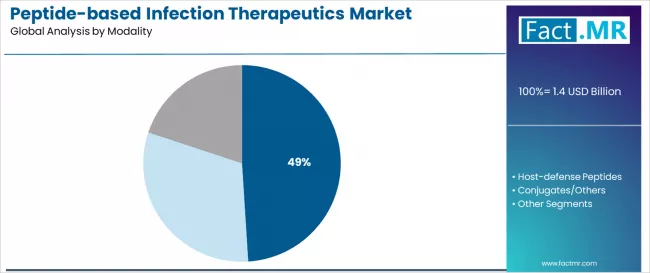
Direct antimicrobial peptides demonstrate market leadership in the peptide-based infection therapeutics market with 49% share due to widespread adoption of bactericidal mechanisms and increasing focus on pathogen elimination, rapid infection control, and antimicrobial efficacy optimization applications that maximize therapeutic effectiveness while maintaining clinical safety standards.
Direct antimicrobial operators prioritize therapeutic efficacy, rapid onset action, and integration with existing healthcare infrastructure that enables coordinated treatment across multiple infection management programs. The segment benefits from substantial clinical validation and research programs that emphasize the acquisition of advanced antimicrobial systems for infection control and patient safety applications.
Infection control programs incorporate direct antimicrobial peptides as standard components for pathogen elimination, while healthcare facility growth increases demand for rapid-action capabilities that comply with clinical standards and minimize treatment complexity.
Therapeutic dynamics include:
- Strong growth in critical care applications requiring rapid antimicrobial capabilities
- Increasing adoption in hospital-acquired infection management and resistance prevention programs
- Rising integration with antimicrobial stewardship systems for treatment optimization and resistance monitoring assurance
Host-Defense Peptides Applications Maintain Innovation Demand
Host-defense peptide treatments capture 31% market share through specialized immune enhancement requirements in immunocompromised patients, chronic infections, and comprehensive infection management programs. These applications demand immune-modulating peptide systems capable of enhancing natural defenses while providing effective treatment capabilities and immune system optimization.
Conjugates/Others Applications Show Advanced Growth
Conjugate and other therapeutic modalities account for 20% market share, including targeted delivery systems, combination therapies, and specialized formulations requiring advanced capabilities for precision treatment optimization and enhanced therapeutic effectiveness.
By Setting, the Hospital/IV Segment Leads Clinical Applications
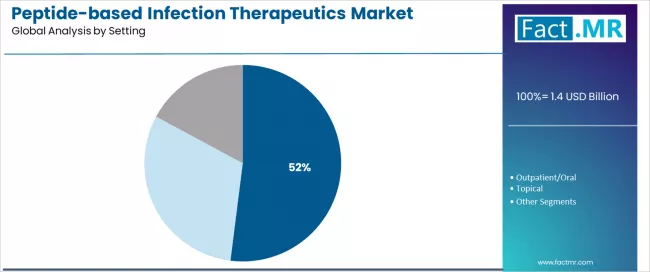
Hospital and IV administration settings command 52% market position with strong growth through optimal critical care approach that balances therapeutic efficacy and clinical monitoring for diverse infection treatment requirements.
This setting segment provides the ideal combination of therapeutic control and clinical oversight, meeting requirements for severe infections, critical care management, and comprehensive monitoring without excessive complexity or safety concerns.
The segment benefits from broad clinical applicability across healthcare sectors, established hospital protocols, and comprehensive patient monitoring that support widespread therapeutic adoption and treatment success.
What are the Drivers, Restraints, and Key Trends of the Peptide-based Infection Therapeutics Market?
| Category | Factor | Impact | Why It Matters |
|---|---|---|---|
| Driver | Antimicrobial resistance crisis & traditional antibiotic failure | ★★★★★ | Growing resistance rates create urgent need for novel mechanisms that circumvent established resistance pathways |
| Driver | Hospital-acquired infections & healthcare-associated pathogens | ★★★★★ | Nosocomial infections drive demand for advanced antimicrobials; peptides offer rapid action and resistance prevention |
| Driver | Pandemic preparedness & emerging pathogen threats | ★★★★☆ | COVID-19 highlighted need for novel therapeutics; peptides offer broad-spectrum and rapid development potential |
| Restraint | High development costs & complex regulatory pathways | ★★★★☆ | Novel antimicrobial approval requires extensive safety and efficacy data; development costs limit smaller players |
| Restraint | Manufacturing complexity & quality control challenges | ★★★☆☆ | Peptide synthesis and purification require specialized facilities; quality consistency affects clinical adoption |
| Trend | Combination therapy protocols & synergistic approaches | ★★★★★ | Multi-modal treatment combining peptides with traditional antibiotics enhances efficacy and reduces resistance |
| Trend | Personalized antimicrobial therapy & resistance profiling | ★★★★☆ | Pathogen identification and resistance testing guide peptide selection; precision medicine approaches improve outcomes |
Analysis of the Peptide-based Infection Therapeutics Market by Key Country
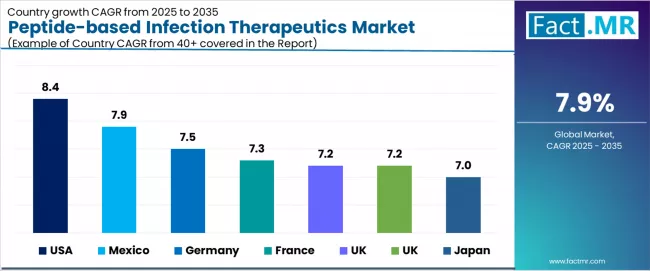
The peptide-based infection therapeutics market demonstrates varied regional dynamics with Growth Leaders including USA (8.4% growth rate) and Mexico (7.9% growth rate) driving expansion through antimicrobial resistance initiatives and healthcare modernization. Strong Performers encompass Germany (7.5% growth rate), France (7.3% growth rate), and developed regions, benefiting from established healthcare systems and advanced infectious disease management. Clinical-Focused Markets feature UK (7.2% growth rate) and Japan (7.0% growth rate), where medical excellence and infection control support strong growth patterns.
Regional synthesis reveals North American markets leading adoption through antimicrobial resistance management and healthcare innovation, while European countries maintain steady growth supported by comprehensive infection control systems and therapeutic development programs. Asian markets show robust growth driven by infection burden and healthcare system advancement trends.
| Region/Country | 2025-2035 Growth | How to win | What to watch out |
|---|---|---|---|
| USA | 8.4% | Lead with resistance solutions | Regulatory complexity; pricing pressure |
| Germany | 7.5% | Focus on clinical excellence | Cost containment; reimbursement challenges |
| UK | 7.2% | Leverage NHS partnerships | Budget constraints; access limitations |
| France | 7.3% | Emphasize hospital integration | Regulatory hurdles; regional variations |
| Japan | 7.0% | Develop precision approaches | Conservative adoption; approval delays |
| South Korea | 7.2% | Build healthcare system integration | Competition intensity; cost sensitivity |
| Mexico | 7.9% | Expand accessibility programs | Infrastructure gaps; quality standards |
USA Drives Market Leadership
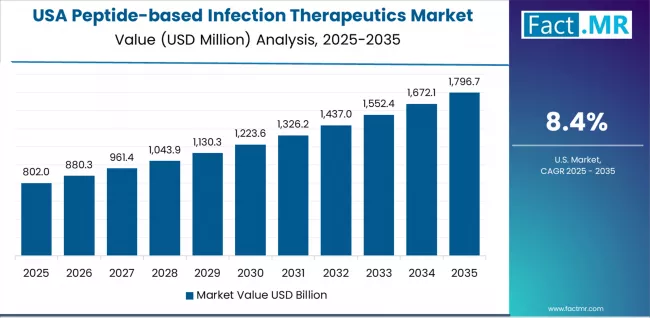
USA establishes market leadership through comprehensive antimicrobial resistance programs and advanced healthcare innovation, integrating peptide-based infection therapeutics as standard components in hospital care and infectious disease management installations. The country's 8.4% growth rate reflects healthcare system sophistication and pharmaceutical innovation programs that mandate the availability of advanced antimicrobial therapies in hospital and specialty care facilities. Growth concentrates in major medical centers, including California, Texas, and New York, where clinical development showcases integrated infection management systems that appeal to healthcare providers seeking advanced therapeutic capabilities and resistance circumvention applications.
American pharmaceutical companies are developing sophisticated peptide antimicrobial solutions that combine domestic research advantages with advanced mechanism features, including multi-target systems and enhanced resistance prevention technologies. Distribution channels through hospital pharmacies and specialty care systems expand market access, while infectious disease specialist adoption supports utilization across diverse patient populations and infection management segments.
Strategic Market Indicators:
- Hospital facilities leading adoption with 82% utilization rate in infectious disease and critical care sectors
- Antimicrobial resistance programs providing substantial market demand for novel therapeutic advancement
- Local pharmaceutical companies capturing 58% market share through innovation leadership and comprehensive antimicrobial offerings
- Export market development for advanced peptide solutions targeting international healthcare markets
United Kingdom Shows NHS Integration Excellence
United Kingdom demonstrates market strength through NHS integration programs and comprehensive infection control initiatives, maintaining a 7.2% growth rate supported by healthcare system efficiency and antimicrobial stewardship optimization. The country leverages its established NHS infrastructure and clinical excellence programs to drive peptide therapeutic adoption across hospital management and infectious disease treatment applications. Major healthcare regions in London, Manchester, and Scotland showcase advanced infection control capabilities that integrate with comprehensive antimicrobial services and resistance monitoring programs.
British market dynamics focus on cost-effective peptide therapeutics that balance clinical efficacy with healthcare system sustainability requirements important to UK healthcare providers and infection control specialists. The market benefits from NICE evaluation processes supporting evidence-based therapeutic adoption and NHS partnerships that create sustained demand for clinically proven antimicrobial therapies in hospital and specialty care applications.
Market Intelligence Brief:
- NHS integration and hospital providers leading growth with emphasis on clinical effectiveness and antimicrobial stewardship optimization
- Healthcare system partnerships driving evidence-based therapeutic adoption and infection control improvement programs
- Government healthcare initiatives supporting antimicrobial resistance management and clinical excellence programs
- Brexit considerations influencing pharmaceutical supply chains and European regulatory alignment strategies
Germany Emerges as Clinical Excellence Leader
In Berlin, Munich, and Hamburg, hospital facilities and infectious disease centers are implementing advanced peptide therapeutics as standard components for infection management and antimicrobial resistance optimization applications, driven by increasing healthcare quality initiatives and clinical excellence programs that emphasize the importance of treatment outcome capabilities. The market holds a 7.5% growth rate, supported by healthcare system quality initiatives and pharmaceutical integration development programs that promote premium therapeutic systems for hospital and specialty facilities. German healthcare providers are adopting peptide therapies that provide consistent therapeutic performance and clinical outcome features, particularly appealing in regions where treatment efficacy and patient safety represent critical healthcare requirements.
Market expansion benefits from established healthcare infrastructure capabilities and international pharmaceutical partnerships that enable domestic integration of advanced therapeutic systems for patient care and clinical applications. Healthcare adoption follows patterns established in infectious disease management, where clinical evidence and resistance prevention drive treatment decisions and clinical deployment.
Market Intelligence Brief:
- Healthcare quality and infectious disease segments driving adoption with 65% annual growth in advanced therapeutic utilization
- Clinical excellence programs emphasizing peptide therapies for infection management and resistance prevention improvement
- Local healthcare systems partnering with international providers for advanced therapeutic integration
- Hospital facilities implementing premium therapeutic systems for patient care optimization and infection control management
France Maintains Hospital Integration Position
France's peptide-based infection therapeutics market demonstrates sophisticated healthcare capabilities with documented effectiveness in hospital care applications through integration with existing healthcare systems and pharmaceutical infrastructure. The country leverages medical expertise and healthcare system integration to maintain a 7.3% growth rate. Healthcare centers, including Paris, Lyon, and Marseille, showcase premium installations where peptide therapeutics integrate with comprehensive infection management platforms and antimicrobial stewardship systems to optimize patient treatment operations and clinical effectiveness.
French healthcare companies prioritize clinical innovation and EU regulatory compliance in therapeutic development, creating demand for advanced systems with sophisticated features, including hospital integration and clinical outcome optimization systems. The market benefits from established healthcare infrastructure and investment in therapeutic advancement that provides long-term patient benefits and compliance with international medical standards.
Strategic Market Considerations:
- Innovation focus on EU healthcare standardization and clinical excellence, driving premium therapeutic segment growth
- Healthcare partnerships providing enhanced clinical capabilities and faster patient access cycles
- Technology collaboration between French companies and international pharmaceutical organizations
- Medical training programs expanding therapeutic integration in infection management scenarios
Japan Shows Precision Treatment Focus
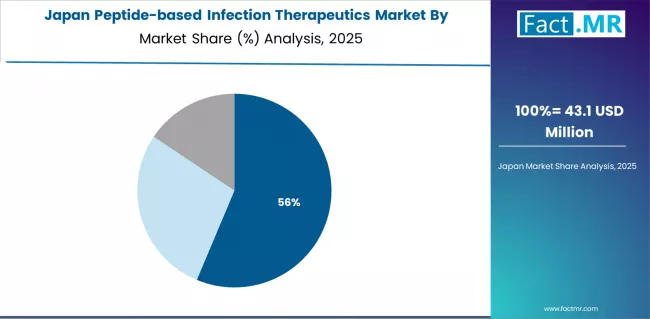
Japan's market expansion benefits from precision healthcare demand, including advanced infection treatments in Tokyo and Osaka, healthcare facility modernization, and medical technology programs that increasingly incorporate peptide therapeutics for patient care optimization applications. The country maintains a 7.0% growth rate, driven by healthcare technology advancement and increasing recognition of antimicrobial therapy benefits, including precise pathogen targeting and comprehensive infection control enhancement.
Market dynamics focus on high-precision therapeutic solutions that balance advanced efficacy with safety considerations important to Japanese healthcare providers. Growing healthcare technology integration creates continued demand for sophisticated peptide therapeutics in medical infrastructure and patient care modernization projects.
Market Intelligence Brief:
- Healthcare technology and medical segments leading growth with focus on precision treatment and infection control optimization applications
- Regional healthcare requirements driving diverse therapeutic portfolio from basic antimicrobial care to advanced infection management systems
- Technology advancement emphasis on precision medicine and clinical outcome control systems
- Government healthcare initiatives supporting domestic medical capabilities and technological competitiveness
South Korea Drives Healthcare Innovation
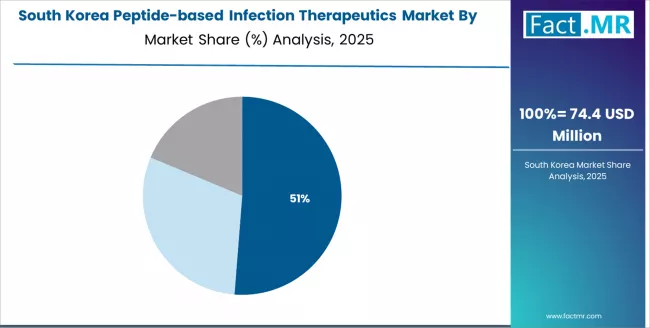
South Korea establishes strong market position through healthcare innovation programs and medical system modernization expansion, integrating advanced peptide therapeutics as standard components for infection control and antimicrobial management optimization applications. The country's 7.2% growth rate reflects government healthcare initiatives and medical modernization programs that emphasize advanced therapeutic systems for patient care enhancement and clinical optimization. Growth concentrates in major healthcare centers, including Seoul and Busan, where medical development showcases integrated therapeutic systems that appeal to healthcare providers seeking comprehensive infection management capabilities and clinical outcome applications.
Korean healthcare companies are developing innovative peptide therapeutic solutions that combine domestic medical innovation advantages with advanced treatment features, including healthcare system integration and enhanced infection control capabilities. Distribution channels through hospital pharmacies and healthcare suppliers expand market access, while government support for healthcare innovation supports adoption across patient care and medical segments.
Strategic Market Indicators:
- Healthcare innovation facilities leading adoption with 68% deployment rate in hospital and clinic sectors
- Government healthcare programs providing substantial funding for domestic medical advancement
- Local healthcare companies capturing significant market share through innovation leadership and healthcare integration expertise
- Export market development for advanced therapeutic solutions targeting regional healthcare markets
Mexico Shows Healthcare Expansion
Mexico's market expansion benefits from growing healthcare modernization, including medical system development in Mexico City and Guadalajara, hospital facility upgrades, and government health programs that increasingly incorporate peptide therapeutic solutions for infection management optimization applications. The country maintains a 7.9% growth rate, driven by healthcare industry growth and increasing adoption of advanced medical solutions, including sophisticated antimicrobial technology and infection control enhancement.
Market dynamics focus on accessible therapeutic solutions that balance efficacy with affordability considerations important to Mexican healthcare providers and patients. Growing healthcare modernization creates continued demand for effective peptide therapeutics in facility expansion and infection control improvement projects.
Strategic Market Considerations:
- Healthcare expansion segments leading growth with focus on accessibility and infection control optimization applications
- Regional healthcare requirements driving diverse therapeutic portfolio from basic antimicrobial treatment to comprehensive infection management systems
- Import considerations balanced by potential domestic healthcare partnerships with international pharmaceutical providers
- Government healthcare initiatives influencing medical access standards and infection control requirements
Europe Market Split by Country
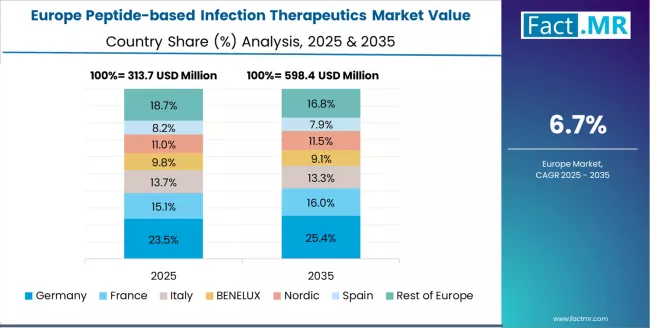
The Europe peptide-based infection therapeutics market is projected to grow from USD 385.0 million in 2025 to USD 795.0 million by 2035, registering a CAGR of 7.5% over the forecast period. Germany is expected to maintain its leadership position with a 28.9% market share in 2025, supported by its advanced healthcare infrastructure and major medical centers.
United Kingdom follows with a 25.7% share in 2025, driven by comprehensive NHS programs and infection control excellence initiatives. France holds a 22.8% share through specialized healthcare applications and clinical innovation requirements. Italy commands a 13.2% share, while Spain accounts for 6.5% in 2025. The Rest of Western Europe region is anticipated to gain momentum, expanding its collective share from 2.9% to 3.4% by 2035, attributed to increasing healthcare investment in Nordic countries and emerging medical facilities implementing therapeutic advancement programs.
Bacterial Infection Treatments Dominate Therapeutic Applications in Germany
In Germany, the peptide-based infection therapeutics market prioritizes bacterial infection treatments, which capture the dominant 54% share of hospital and specialty installations due to their advanced features, including precision antimicrobial mechanisms and seamless integration with existing infection control infrastructure. German healthcare operators emphasize efficacy, safety compliance, and long-term clinical excellence, creating demand for bacterial treatment systems that provide consistent pathogen elimination capabilities and adaptive performance based on resistance patterns and clinical conditions. Other pathogen targets maintain secondary positions primarily in specialized applications and immunocompromised patient facilities where comprehensive care functionality meets clinical requirements without compromising treatment effectiveness.
Market Characteristics:
- Premium focus on bacterial infection treatments with advanced antimicrobial mechanisms and precision pathogen targeting capabilities
- Integration requirements with existing healthcare platforms and infection control management systems
- Emphasis on resistance prevention and long-term antimicrobial effectiveness in therapeutic applications
Pharmaceutical Companies Lead Therapeutic Development in United Kingdom
In United Kingdom, the market structure favors international pharmaceutical companies, including Melinta/IQVIA, Pfizer, and Merck, which maintain dominant positions through comprehensive therapeutic portfolios and established healthcare networks supporting both NHS and private antimicrobial installations. These providers offer integrated solutions combining advanced peptide therapeutics with professional clinical services and ongoing infection management support that appeal to British healthcare providers seeking reliable treatment systems. Local healthcare contractors and specialty pharmacies capture a moderate market share by providing localized patient care capabilities and competitive pricing for standard therapeutic installations, while domestic companies focus on specialized applications and premium solutions tailored to British healthcare characteristics.
Channel Insights:
- International pharmaceutical brands maintaining premium market positioning through advanced therapeutic offerings
- Local healthcare service networks expanding to support growing demand for professional infection management and clinical support
- Healthcare integration capabilities becoming a key differentiator for system-wide and clinical platform applications
Competitive Landscape of the Peptide-based Infection Therapeutics Market
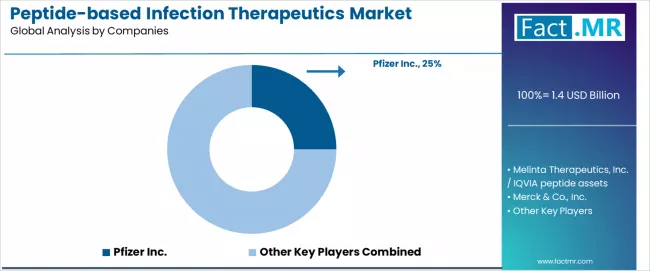
- Structure: ~10-15 credible players; top 3-5 hold ~60-65% by revenue.
- Leadership is maintained through: clinical efficacy, regulatory approval, and hospital integration capabilities.
- What's commoditizing: basic antimicrobial mechanisms and standard formulations.
- Margin Opportunities: combination therapies, resistance circumvention, and integrated treatment protocols.
| Stakeholder | What they actually control | Typical strengths | Typical blind spots |
|---|---|---|---|
| Big pharma leaders | Pipeline depth, regulatory expertise, hospital access | Proven efficacy, comprehensive support, market reach | Innovation speed; niche pathogens |
| Specialty antimicrobials | Novel mechanisms, resistance solutions, targeted approaches | Innovation leadership, specialized expertise | Scale limitations; market access |
| Academic spinouts | Research innovation, novel targets, early-stage development | Scientific excellence, IP position | Commercial expertise; manufacturing scale |
| Hospital integrators | Clinical protocols, infection control, outcome tracking | Healthcare integration, clinical relationships | Therapeutic development; regulatory expertise |
Key Players in the Peptide-based Infection Therapeutics Market
- Melinta Therapeutics, Inc. / IQVIA peptide assets
- Pfizer Inc.
- Merck & Co., Inc.
- Roche Holding AG
- Polyphor Ltd. (legacy assets)
- Spero Therapeutics, Inc.
- Destiny Pharma plc
- Summit Therapeutics plc
- ContraFect Corporation
- Basilea Pharmaceutica International Ltd.
Scope of the Report
| Item | Value |
|---|---|
| Quantitative Units | USD 1.4 billion |
| Pathogen Target | Bacterial, Viral, Fungal/Others |
| Modality | Direct Antimicrobials, Host-defense Peptides, Conjugates/Others |
| Setting | Hospital/IV, Outpatient/Oral, Topical |
| End Use | Critical Care, Infectious Disease Management, Dermatology, Wound Care |
| Regions Covered | North America, Western Europe, East Asia, South Asia Pacific, Latin America, Middle East & Africa |
| Countries Covered | United States, Germany, United Kingdom, France, Japan, South Korea, Mexico, Canada, Italy, and 25+ additional countries |
| Key Companies Profiled | Melinta/IQVIA peptide assets, Pfizer, Merck, Roche, Polyphor legacy, Spero, Destiny Pharma, Summit, ContraFect, Basilea |
| Additional Attributes | Dollar sales by pathogen target and modality categories, regional adoption trends across North America, Western Europe, and East Asia, competitive landscape with pharmaceutical manufacturers and healthcare providers, clinician preferences for efficacy optimization and resistance prevention, integration with infection control platforms and antimicrobial stewardship systems, innovations in peptide antimicrobial technology and delivery enhancement, and development of combination therapeutic solutions with enhanced performance and resistance circumvention capabilities. |
Peptide-based Infection Therapeutics Market by Segments
-
Pathogen Target :
- Bacterial
- Viral
- Fungal/Others
-
Modality :
- Direct Antimicrobials
- Host-defense Peptides
- Conjugates/Others
-
Setting :
- Hospital/IV
- Outpatient/Oral
- Topical
-
End Use :
- Critical Care
- Infectious Disease Management
- Dermatology
- Wound Care
-
Region :
- North America
- United States
- Canada
- Mexico
- Western Europe
- Germany
- United Kingdom
- France
- Italy
- Spain
- Nordic
- BENELUX
- Rest of Western Europe
- East Asia
- China
- Japan
- South Korea
- South Asia Pacific
- India
- ASEAN
- Australia & New Zealand
- Rest of South Asia Pacific
- Latin America
- Brazil
- Chile
- Rest of Latin America
- Middle East & Africa
- Kingdom of Saudi Arabia
- Other GCC Countries
- Turkey
- South Africa
- Other African Union
- Rest of Middle East & Africa
- North America
Table of Content
- Executive Summary
- Global Market Outlook
- Demand to side Trends
- Supply to side Trends
- Technology Roadmap Analysis
- Analysis and Recommendations
- Market Overview
- Market Coverage / Taxonomy
- Market Definition / Scope / Limitations
- Market Background
- Market Dynamics
- Drivers
- Restraints
- Opportunity
- Trends
- Scenario Forecast
- Demand in Optimistic Scenario
- Demand in Likely Scenario
- Demand in Conservative Scenario
- Opportunity Map Analysis
- Product Life Cycle Analysis
- Supply Chain Analysis
- Investment Feasibility Matrix
- Value Chain Analysis
- PESTLE and Porter’s Analysis
- Regulatory Landscape
- Regional Parent Market Outlook
- Production and Consumption Statistics
- Import and Export Statistics
- Market Dynamics
- Global Market Analysis 2020 to 2024 and Forecast, 2025 to 2035
- Historical Market Size Value (USD Million) Analysis, 2020 to 2024
- Current and Future Market Size Value (USD Million) Projections, 2025 to 2035
- Y to o to Y Growth Trend Analysis
- Absolute $ Opportunity Analysis
- Global Market Pricing Analysis 2020 to 2024 and Forecast 2025 to 2035
- Global Market Analysis 2020 to 2024 and Forecast 2025 to 2035, By Pathogen Target
- Introduction / Key Findings
- Historical Market Size Value (USD Million) Analysis By Pathogen Target , 2020 to 2024
- Current and Future Market Size Value (USD Million) Analysis and Forecast By Pathogen Target , 2025 to 2035
- Bacterial
- Viral
- Fungal/Others
- Y to o to Y Growth Trend Analysis By Pathogen Target , 2020 to 2024
- Absolute $ Opportunity Analysis By Pathogen Target , 2025 to 2035
- Global Market Analysis 2020 to 2024 and Forecast 2025 to 2035, By Modality
- Introduction / Key Findings
- Historical Market Size Value (USD Million) Analysis By Modality, 2020 to 2024
- Current and Future Market Size Value (USD Million) Analysis and Forecast By Modality, 2025 to 2035
- Direct Antimicrobials
- Host-defense Peptides
- Conjugates/Others
- Y to o to Y Growth Trend Analysis By Modality, 2020 to 2024
- Absolute $ Opportunity Analysis By Modality, 2025 to 2035
- Global Market Analysis 2020 to 2024 and Forecast 2025 to 2035, By Setting
- Introduction / Key Findings
- Historical Market Size Value (USD Million) Analysis By Setting, 2020 to 2024
- Current and Future Market Size Value (USD Million) Analysis and Forecast By Setting, 2025 to 2035
- Hospital/IV
- Outpatient/Oral
- Topical
- Y to o to Y Growth Trend Analysis By Setting, 2020 to 2024
- Absolute $ Opportunity Analysis By Setting, 2025 to 2035
- Global Market Analysis 2020 to 2024 and Forecast 2025 to 2035, By Region
- Introduction
- Historical Market Size Value (USD Million) Analysis By Region, 2020 to 2024
- Current Market Size Value (USD Million) Analysis and Forecast By Region, 2025 to 2035
- North America
- Latin America
- Western Europe
- Eastern Europe
- East Asia
- South Asia and Pacific
- Middle East & Africa
- Market Attractiveness Analysis By Region
- North America Market Analysis 2020 to 2024 and Forecast 2025 to 2035, By Country
- Historical Market Size Value (USD Million) Trend Analysis By Market Taxonomy, 2020 to 2024
- Market Size Value (USD Million) Forecast By Market Taxonomy, 2025 to 2035
- By Country
- USA
- Canada
- Mexico
- By Pathogen Target
- By Modality
- By Setting
- By Country
- Market Attractiveness Analysis
- By Country
- By Pathogen Target
- By Modality
- By Setting
- Key Takeaways
- Latin America Market Analysis 2020 to 2024 and Forecast 2025 to 2035, By Country
- Historical Market Size Value (USD Million) Trend Analysis By Market Taxonomy, 2020 to 2024
- Market Size Value (USD Million) Forecast By Market Taxonomy, 2025 to 2035
- By Country
- Brazil
- Chile
- Rest of Latin America
- By Pathogen Target
- By Modality
- By Setting
- By Country
- Market Attractiveness Analysis
- By Country
- By Pathogen Target
- By Modality
- By Setting
- Key Takeaways
- Western Europe Market Analysis 2020 to 2024 and Forecast 2025 to 2035, By Country
- Historical Market Size Value (USD Million) Trend Analysis By Market Taxonomy, 2020 to 2024
- Market Size Value (USD Million) Forecast By Market Taxonomy, 2025 to 2035
- By Country
- Germany
- UK
- Italy
- Spain
- France
- Nordic
- BENELUX
- Rest of Western Europe
- By Pathogen Target
- By Modality
- By Setting
- By Country
- Market Attractiveness Analysis
- By Country
- By Pathogen Target
- By Modality
- By Setting
- Key Takeaways
- Eastern Europe Market Analysis 2020 to 2024 and Forecast 2025 to 2035, By Country
- Historical Market Size Value (USD Million) Trend Analysis By Market Taxonomy, 2020 to 2024
- Market Size Value (USD Million) Forecast By Market Taxonomy, 2025 to 2035
- By Country
- Russia
- Poland
- Hungary
- Balkan & Baltic
- Rest of Eastern Europe
- By Pathogen Target
- By Modality
- By Setting
- By Country
- Market Attractiveness Analysis
- By Country
- By Pathogen Target
- By Modality
- By Setting
- Key Takeaways
- East Asia Market Analysis 2020 to 2024 and Forecast 2025 to 2035, By Country
- Historical Market Size Value (USD Million) Trend Analysis By Market Taxonomy, 2020 to 2024
- Market Size Value (USD Million) Forecast By Market Taxonomy, 2025 to 2035
- By Country
- China
- Japan
- South Korea
- By Pathogen Target
- By Modality
- By Setting
- By Country
- Market Attractiveness Analysis
- By Country
- By Pathogen Target
- By Modality
- By Setting
- Key Takeaways
- South Asia and Pacific Market Analysis 2020 to 2024 and Forecast 2025 to 2035, By Country
- Historical Market Size Value (USD Million) Trend Analysis By Market Taxonomy, 2020 to 2024
- Market Size Value (USD Million) Forecast By Market Taxonomy, 2025 to 2035
- By Country
- India
- ASEAN
- Australia & New Zealand
- Rest of South Asia and Pacific
- By Pathogen Target
- By Modality
- By Setting
- By Country
- Market Attractiveness Analysis
- By Country
- By Pathogen Target
- By Modality
- By Setting
- Key Takeaways
- Middle East & Africa Market Analysis 2020 to 2024 and Forecast 2025 to 2035, By Country
- Historical Market Size Value (USD Million) Trend Analysis By Market Taxonomy, 2020 to 2024
- Market Size Value (USD Million) Forecast By Market Taxonomy, 2025 to 2035
- By Country
- Kingdom of Saudi Arabia
- Other GCC Countries
- Turkiye
- South Africa
- Other African Union
- Rest of Middle East & Africa
- By Pathogen Target
- By Modality
- By Setting
- By Country
- Market Attractiveness Analysis
- By Country
- By Pathogen Target
- By Modality
- By Setting
- Key Takeaways
- Key Countries Market Analysis
- USA
- Pricing Analysis
- Market Share Analysis, 2024
- By Pathogen Target
- By Modality
- By Setting
- Canada
- Pricing Analysis
- Market Share Analysis, 2024
- By Pathogen Target
- By Modality
- By Setting
- Mexico
- Pricing Analysis
- Market Share Analysis, 2024
- By Pathogen Target
- By Modality
- By Setting
- Brazil
- Pricing Analysis
- Market Share Analysis, 2024
- By Pathogen Target
- By Modality
- By Setting
- Chile
- Pricing Analysis
- Market Share Analysis, 2024
- By Pathogen Target
- By Modality
- By Setting
- Germany
- Pricing Analysis
- Market Share Analysis, 2024
- By Pathogen Target
- By Modality
- By Setting
- UK
- Pricing Analysis
- Market Share Analysis, 2024
- By Pathogen Target
- By Modality
- By Setting
- Italy
- Pricing Analysis
- Market Share Analysis, 2024
- By Pathogen Target
- By Modality
- By Setting
- Spain
- Pricing Analysis
- Market Share Analysis, 2024
- By Pathogen Target
- By Modality
- By Setting
- France
- Pricing Analysis
- Market Share Analysis, 2024
- By Pathogen Target
- By Modality
- By Setting
- India
- Pricing Analysis
- Market Share Analysis, 2024
- By Pathogen Target
- By Modality
- By Setting
- ASEAN
- Pricing Analysis
- Market Share Analysis, 2024
- By Pathogen Target
- By Modality
- By Setting
- Australia & New Zealand
- Pricing Analysis
- Market Share Analysis, 2024
- By Pathogen Target
- By Modality
- By Setting
- China
- Pricing Analysis
- Market Share Analysis, 2024
- By Pathogen Target
- By Modality
- By Setting
- Japan
- Pricing Analysis
- Market Share Analysis, 2024
- By Pathogen Target
- By Modality
- By Setting
- South Korea
- Pricing Analysis
- Market Share Analysis, 2024
- By Pathogen Target
- By Modality
- By Setting
- Russia
- Pricing Analysis
- Market Share Analysis, 2024
- By Pathogen Target
- By Modality
- By Setting
- Poland
- Pricing Analysis
- Market Share Analysis, 2024
- By Pathogen Target
- By Modality
- By Setting
- Hungary
- Pricing Analysis
- Market Share Analysis, 2024
- By Pathogen Target
- By Modality
- By Setting
- Kingdom of Saudi Arabia
- Pricing Analysis
- Market Share Analysis, 2024
- By Pathogen Target
- By Modality
- By Setting
- Turkiye
- Pricing Analysis
- Market Share Analysis, 2024
- By Pathogen Target
- By Modality
- By Setting
- South Africa
- Pricing Analysis
- Market Share Analysis, 2024
- By Pathogen Target
- By Modality
- By Setting
- USA
- Market Structure Analysis
- Competition Dashboard
- Competition Benchmarking
- Market Share Analysis of Top Players
- By Regional
- By Pathogen Target
- By Modality
- By Setting
- Competition Analysis
- Competition Deep Dive
- Pfizer Inc.
- Overview
- Product Portfolio
- Profitability by Market Segments (Product/Age /Sales Channel/Region)
- Sales Footprint
- Strategy Overview
- Marketing Strategy
- Product Strategy
- Channel Strategy
- Melinta Therapeutics, Inc. / IQVIA peptide assets
- Merck & Co., Inc.
- Roche Holding AG
- Polyphor Ltd. (legacy assets)
- Spero Therapeutics, Inc.
- Destiny Pharma plc
- Summit Therapeutics plc
- ContraFect Corporation
- Basilea Pharmaceutica International Ltd.
- Pfizer Inc.
- Competition Deep Dive
- Assumptions & Acronyms Used
- Research Methodology
List Of Table
- Table 1: Global Market Value (USD Million) Forecast by Region, 2020 to 2035
- Table 2: Global Market Value (USD Million) Forecast by Pathogen Target , 2020 to 2035
- Table 3: Global Market Value (USD Million) Forecast by Modality, 2020 to 2035
- Table 4: Global Market Value (USD Million) Forecast by Setting, 2020 to 2035
- Table 5: North America Market Value (USD Million) Forecast by Country, 2020 to 2035
- Table 6: North America Market Value (USD Million) Forecast by Pathogen Target , 2020 to 2035
- Table 7: North America Market Value (USD Million) Forecast by Modality, 2020 to 2035
- Table 8: North America Market Value (USD Million) Forecast by Setting, 2020 to 2035
- Table 9: Latin America Market Value (USD Million) Forecast by Country, 2020 to 2035
- Table 10: Latin America Market Value (USD Million) Forecast by Pathogen Target , 2020 to 2035
- Table 11: Latin America Market Value (USD Million) Forecast by Modality, 2020 to 2035
- Table 12: Latin America Market Value (USD Million) Forecast by Setting, 2020 to 2035
- Table 13: Western Europe Market Value (USD Million) Forecast by Country, 2020 to 2035
- Table 14: Western Europe Market Value (USD Million) Forecast by Pathogen Target , 2020 to 2035
- Table 15: Western Europe Market Value (USD Million) Forecast by Modality, 2020 to 2035
- Table 16: Western Europe Market Value (USD Million) Forecast by Setting, 2020 to 2035
- Table 17: Eastern Europe Market Value (USD Million) Forecast by Country, 2020 to 2035
- Table 18: Eastern Europe Market Value (USD Million) Forecast by Pathogen Target , 2020 to 2035
- Table 19: Eastern Europe Market Value (USD Million) Forecast by Modality, 2020 to 2035
- Table 20: Eastern Europe Market Value (USD Million) Forecast by Setting, 2020 to 2035
- Table 21: East Asia Market Value (USD Million) Forecast by Country, 2020 to 2035
- Table 22: East Asia Market Value (USD Million) Forecast by Pathogen Target , 2020 to 2035
- Table 23: East Asia Market Value (USD Million) Forecast by Modality, 2020 to 2035
- Table 24: East Asia Market Value (USD Million) Forecast by Setting, 2020 to 2035
- Table 25: South Asia and Pacific Market Value (USD Million) Forecast by Country, 2020 to 2035
- Table 26: South Asia and Pacific Market Value (USD Million) Forecast by Pathogen Target , 2020 to 2035
- Table 27: South Asia and Pacific Market Value (USD Million) Forecast by Modality, 2020 to 2035
- Table 28: South Asia and Pacific Market Value (USD Million) Forecast by Setting, 2020 to 2035
- Table 29: Middle East & Africa Market Value (USD Million) Forecast by Country, 2020 to 2035
- Table 30: Middle East & Africa Market Value (USD Million) Forecast by Pathogen Target , 2020 to 2035
- Table 31: Middle East & Africa Market Value (USD Million) Forecast by Modality, 2020 to 2035
- Table 32: Middle East & Africa Market Value (USD Million) Forecast by Setting, 2020 to 2035
List Of Figures
- Figure 1: Global Market Pricing Analysis
- Figure 2: Global Market Value (USD Million) Forecast 2020-2035
- Figure 3: Global Market Value Share and BPS Analysis by Pathogen Target , 2025 and 2035
- Figure 4: Global Market Y to o to Y Growth Comparison by Pathogen Target , 2025-2035
- Figure 5: Global Market Attractiveness Analysis by Pathogen Target
- Figure 6: Global Market Value Share and BPS Analysis by Modality, 2025 and 2035
- Figure 7: Global Market Y to o to Y Growth Comparison by Modality, 2025-2035
- Figure 8: Global Market Attractiveness Analysis by Modality
- Figure 9: Global Market Value Share and BPS Analysis by Setting, 2025 and 2035
- Figure 10: Global Market Y to o to Y Growth Comparison by Setting, 2025-2035
- Figure 11: Global Market Attractiveness Analysis by Setting
- Figure 12: Global Market Value (USD Million) Share and BPS Analysis by Region, 2025 and 2035
- Figure 13: Global Market Y to o to Y Growth Comparison by Region, 2025-2035
- Figure 14: Global Market Attractiveness Analysis by Region
- Figure 15: North America Market Incremental Dollar Opportunity, 2025-2035
- Figure 16: Latin America Market Incremental Dollar Opportunity, 2025-2035
- Figure 17: Western Europe Market Incremental Dollar Opportunity, 2025-2035
- Figure 18: Eastern Europe Market Incremental Dollar Opportunity, 2025-2035
- Figure 19: East Asia Market Incremental Dollar Opportunity, 2025-2035
- Figure 20: South Asia and Pacific Market Incremental Dollar Opportunity, 2025-2035
- Figure 21: Middle East & Africa Market Incremental Dollar Opportunity, 2025-2035
- Figure 22: North America Market Value Share and BPS Analysis by Country, 2025 and 2035
- Figure 23: North America Market Value Share and BPS Analysis by Pathogen Target , 2025 and 2035
- Figure 24: North America Market Y to o to Y Growth Comparison by Pathogen Target , 2025-2035
- Figure 25: North America Market Attractiveness Analysis by Pathogen Target
- Figure 26: North America Market Value Share and BPS Analysis by Modality, 2025 and 2035
- Figure 27: North America Market Y to o to Y Growth Comparison by Modality, 2025-2035
- Figure 28: North America Market Attractiveness Analysis by Modality
- Figure 29: North America Market Value Share and BPS Analysis by Setting, 2025 and 2035
- Figure 30: North America Market Y to o to Y Growth Comparison by Setting, 2025-2035
- Figure 31: North America Market Attractiveness Analysis by Setting
- Figure 32: Latin America Market Value Share and BPS Analysis by Country, 2025 and 2035
- Figure 33: Latin America Market Value Share and BPS Analysis by Pathogen Target , 2025 and 2035
- Figure 34: Latin America Market Y to o to Y Growth Comparison by Pathogen Target , 2025-2035
- Figure 35: Latin America Market Attractiveness Analysis by Pathogen Target
- Figure 36: Latin America Market Value Share and BPS Analysis by Modality, 2025 and 2035
- Figure 37: Latin America Market Y to o to Y Growth Comparison by Modality, 2025-2035
- Figure 38: Latin America Market Attractiveness Analysis by Modality
- Figure 39: Latin America Market Value Share and BPS Analysis by Setting, 2025 and 2035
- Figure 40: Latin America Market Y to o to Y Growth Comparison by Setting, 2025-2035
- Figure 41: Latin America Market Attractiveness Analysis by Setting
- Figure 42: Western Europe Market Value Share and BPS Analysis by Country, 2025 and 2035
- Figure 43: Western Europe Market Value Share and BPS Analysis by Pathogen Target , 2025 and 2035
- Figure 44: Western Europe Market Y to o to Y Growth Comparison by Pathogen Target , 2025-2035
- Figure 45: Western Europe Market Attractiveness Analysis by Pathogen Target
- Figure 46: Western Europe Market Value Share and BPS Analysis by Modality, 2025 and 2035
- Figure 47: Western Europe Market Y to o to Y Growth Comparison by Modality, 2025-2035
- Figure 48: Western Europe Market Attractiveness Analysis by Modality
- Figure 49: Western Europe Market Value Share and BPS Analysis by Setting, 2025 and 2035
- Figure 50: Western Europe Market Y to o to Y Growth Comparison by Setting, 2025-2035
- Figure 51: Western Europe Market Attractiveness Analysis by Setting
- Figure 52: Eastern Europe Market Value Share and BPS Analysis by Country, 2025 and 2035
- Figure 53: Eastern Europe Market Value Share and BPS Analysis by Pathogen Target , 2025 and 2035
- Figure 54: Eastern Europe Market Y to o to Y Growth Comparison by Pathogen Target , 2025-2035
- Figure 55: Eastern Europe Market Attractiveness Analysis by Pathogen Target
- Figure 56: Eastern Europe Market Value Share and BPS Analysis by Modality, 2025 and 2035
- Figure 57: Eastern Europe Market Y to o to Y Growth Comparison by Modality, 2025-2035
- Figure 58: Eastern Europe Market Attractiveness Analysis by Modality
- Figure 59: Eastern Europe Market Value Share and BPS Analysis by Setting, 2025 and 2035
- Figure 60: Eastern Europe Market Y to o to Y Growth Comparison by Setting, 2025-2035
- Figure 61: Eastern Europe Market Attractiveness Analysis by Setting
- Figure 62: East Asia Market Value Share and BPS Analysis by Country, 2025 and 2035
- Figure 63: East Asia Market Value Share and BPS Analysis by Pathogen Target , 2025 and 2035
- Figure 64: East Asia Market Y to o to Y Growth Comparison by Pathogen Target , 2025-2035
- Figure 65: East Asia Market Attractiveness Analysis by Pathogen Target
- Figure 66: East Asia Market Value Share and BPS Analysis by Modality, 2025 and 2035
- Figure 67: East Asia Market Y to o to Y Growth Comparison by Modality, 2025-2035
- Figure 68: East Asia Market Attractiveness Analysis by Modality
- Figure 69: East Asia Market Value Share and BPS Analysis by Setting, 2025 and 2035
- Figure 70: East Asia Market Y to o to Y Growth Comparison by Setting, 2025-2035
- Figure 71: East Asia Market Attractiveness Analysis by Setting
- Figure 72: South Asia and Pacific Market Value Share and BPS Analysis by Country, 2025 and 2035
- Figure 73: South Asia and Pacific Market Value Share and BPS Analysis by Pathogen Target , 2025 and 2035
- Figure 74: South Asia and Pacific Market Y to o to Y Growth Comparison by Pathogen Target , 2025-2035
- Figure 75: South Asia and Pacific Market Attractiveness Analysis by Pathogen Target
- Figure 76: South Asia and Pacific Market Value Share and BPS Analysis by Modality, 2025 and 2035
- Figure 77: South Asia and Pacific Market Y to o to Y Growth Comparison by Modality, 2025-2035
- Figure 78: South Asia and Pacific Market Attractiveness Analysis by Modality
- Figure 79: South Asia and Pacific Market Value Share and BPS Analysis by Setting, 2025 and 2035
- Figure 80: South Asia and Pacific Market Y to o to Y Growth Comparison by Setting, 2025-2035
- Figure 81: South Asia and Pacific Market Attractiveness Analysis by Setting
- Figure 82: Middle East & Africa Market Value Share and BPS Analysis by Country, 2025 and 2035
- Figure 83: Middle East & Africa Market Value Share and BPS Analysis by Pathogen Target , 2025 and 2035
- Figure 84: Middle East & Africa Market Y to o to Y Growth Comparison by Pathogen Target , 2025-2035
- Figure 85: Middle East & Africa Market Attractiveness Analysis by Pathogen Target
- Figure 86: Middle East & Africa Market Value Share and BPS Analysis by Modality, 2025 and 2035
- Figure 87: Middle East & Africa Market Y to o to Y Growth Comparison by Modality, 2025-2035
- Figure 88: Middle East & Africa Market Attractiveness Analysis by Modality
- Figure 89: Middle East & Africa Market Value Share and BPS Analysis by Setting, 2025 and 2035
- Figure 90: Middle East & Africa Market Y to o to Y Growth Comparison by Setting, 2025-2035
- Figure 91: Middle East & Africa Market Attractiveness Analysis by Setting
- Figure 92: Global Market - Tier Structure Analysis
- Figure 93: Global Market - Company Share Analysis
- FAQs -
How big is the peptide-based infection therapeutics market in 2025?
The global peptide-based infection therapeutics market is estimated to be valued at USD 1.4 billion in 2025.
What will be the size of peptide-based infection therapeutics market in 2035?
The market size for the peptide-based infection therapeutics market is projected to reach USD 3.0 billion by 2035.
How much will be the peptide-based infection therapeutics market growth between 2025 and 2035?
The peptide-based infection therapeutics market is expected to grow at a 7.9% CAGR between 2025 and 2035.
What are the key product types in the peptide-based infection therapeutics market?
The key product types in peptide-based infection therapeutics market are bacterial, viral and fungal/others.
Which modality segment to contribute significant share in the peptide-based infection therapeutics market in 2025?
In terms of modality, direct antimicrobials segment to command 49.0% share in the peptide-based infection therapeutics market in 2025.